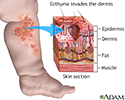Ecthyma
Streptococcus - ecthyma; Strep - ecthyma; Staphylococcus - ecthyma; Staph - ecthyma; Skin infection - ecthyma
Ecthyma is a skin infection. It is similar to impetigo, but occurs deep inside the skin. For this reason, ecthyma is often called deep impetigo.
Causes
Ecthyma is most often caused by the streptococcus bacteria. Sometimes, staphylococcus bacteria cause this skin infection on its own or in combination with streptococcus.
The infection may start in skin that has been injured due to a scratch, rash, or insect bite. The infection often develops on the legs. People with diabetes or a weakened immune system are more prone to ecthyma.
Symptoms
The main symptom of ecthyma is a small blister with a red border that may be filled with pus. The blister is similar to that seen with impetigo, but the infection spreads much deeper into the skin.
After the blister goes away, a crusty ulcer appears.
Exams and Tests
Your health care provider can usually diagnose this condition simply by looking at your skin. In rare cases, the fluid inside the blister is sent to a lab for closer examination, or a skin biopsy needs to be done.
Treatment
Your provider will usually prescribe antibiotics that you need to take by mouth (oral antibiotics). Very early cases may be treated with antibiotics that you apply to the affected area (topical antibiotics). Serious infections may need antibiotics given through a vein (intravenous antibiotics).
Placing a warm, wet cloth over the area can help remove ulcer crusts. Your provider may recommend antiseptic soap or peroxide washes to speed recovery.
Outlook (Prognosis)
Ecthyma can sometimes result in scarring.
Possible Complications
This condition may lead to:
- Spread of infection to other parts of the body
- Permanent skin damage with scarring
When to Contact a Medical Professional
Make an appointment with your provider if you have symptoms of ecthyma.
Prevention
Carefully clean the skin after an injury, such as a bite or scratch. Do not scratch or pick at scabs and sores.
References
James WD, Elston DM, Treat JR, Rosenbach MA, Neuhaus IM. Bacterial infections. In: James WD, Elston DM, Treat JR, Rosenbach MA, Neuhaus IM, eds. Andrews' Diseases of the Skin: Clinical Dermatology. 13th ed. Philadelphia, PA: Elsevier; 2020:chap 14.
Pasternack MS, Swartz MN. Cellulitis, necrotizing fasciitis, and subcutaneous tissue infections. In: Bennett JE, Dolin R, Blaser MJ, eds. Mandell, Douglas, and Bennett's Principles and Practice of Infectious Diseases. 9th ed. Philadelphia, PA: Elsevier; 2020:chap 93.
Review Date: 4/24/2023






